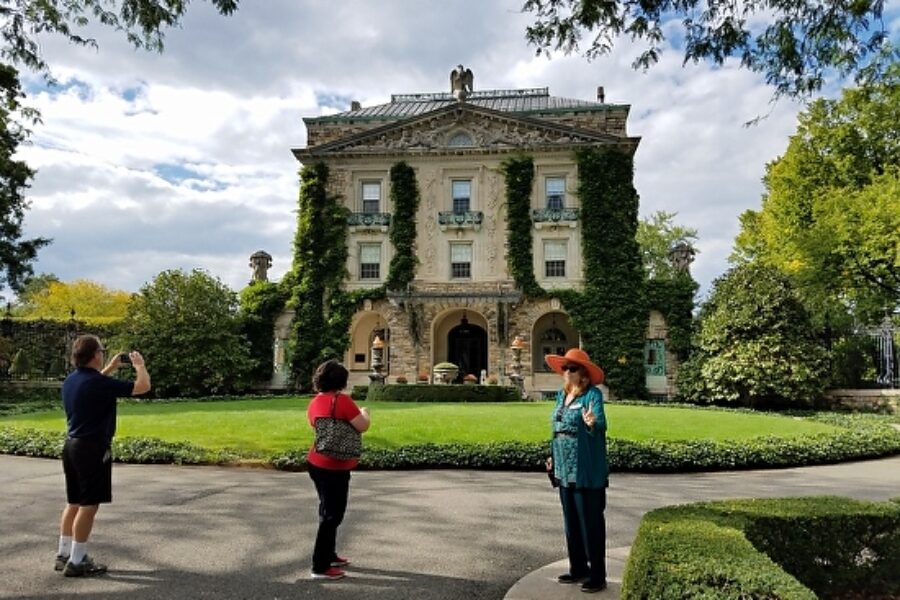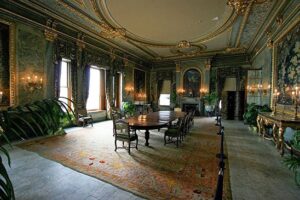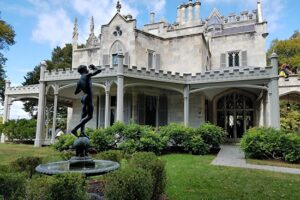We discuss the afternoon’s agenda during lunch, which originally was to be all about Sleepy Hollow Cemetery. Michael continues to insist we have been there before, and he will show me pictures when we get home. I mention Kyquit, the three-generation Rockefeller estate, a stone’s throw from where we sit. I didn’t think I wanted to see one more tycoon’s home, but since we are here—and I do at least know about the Rockefeller’s. “We might as well. What do you think?”
“I’ll do anything you want to do dear.”
A Two-Hour Tour
We purchase two tickets and sit outside on the balcony sipping coffee and munching on a shared pecan bar while we wait for the bus to take us on our 2:30 tour—a two-hour tour. Sleepy Hollow Cemetery may not be in my immediate future; we’ve yet to see if it was part of my history.

The bus chugs along, climbing the tallest hill in the area; thus, the name Kyquit—pronounced Ky-kut—which is Dutch for ‘lookout.’ I didn’t know it when we arrived in the Hudson River Valley, but we are very definitely in Dutch Country. At least this tour answered that question.
Kyquit, the House
The house is unexpectedly unassuming, despite all of the bass relief and curlicues and the fact that it is four stories tall. Maybe it is because it is partially encrusted in rough brownstone and softened with ivy clinging to its walls, and it’s only three windows wide. Michael thinks I am mad when I tell him it looks unassuming. I try to explain, “It’s in your face—but in a nice way. Toned down ostentation. Just a smidgen of wicked excess?” Perhaps it’s the softened color. It doesn’t say look at me; I am grand. It just is.



The grounds on the other hand are another story—they are pretty much wicked excess.


“No pictures once inside,” our guide reminds us. The interior looks surprisingly comfortable; the space is livable, it does not overwhelm—well, not too much. The house is filled with priceless oriental statuary made of glazed and unglazed china. Junior, JDR’s son, apparently was smitten with Chinese art, even borrowing money from his dad—approximately a million dollars according to our guide—to purchase someone else’s collection. Art in some form is everywhere—inside, outside, in the basement.
The interior walls are white on white, like an elegant wedding cake. The furniture comfortable, the draperies understated elegance. Even a TV tucked into the wall of the former study of patriarch JDR is discreetly hidden by a folding panel of faux books when not in use. This space was used as a family room by his grandson Nelson. All this livability is probably because Nelson Rockefeller, a four-term former governor of New York and Vice President of the United States, made Kykuit his home till the late 1970’s when he bequeathed it upon his death to the National Trust for Historic Preservation.
The Gardens
This $25 per person tour includes only the downstairs rooms—and not all of them. After winding our way around the interior—skirting other tours thirty minutes ahead or thirty minutes behind us—we make our way outside to enjoy the gardens and the view from the back terrace.


The side of the Kykuit looms large and looks like a hotel. I think they were trying to achieve understated modesty as visitors approached the front of the house. Two large sunken areas on the grounds prompt an explanation from our guide. “The National Historic Preservation filled in two pools—one for adults and one for kids—when they took over the care of the property.”
I guess maintenance and liability must have been a perceived nightmare. Or an actual one. Our guide herds cats as individuals on the tour continually wander off, skirting barriers and go where they aren’t supposed to.
“Have you ever lost anyone?” I ask.
“Once,” she tells me, “when I first started. And I got in trouble for it.”





Picasso in Tapestry
Returning to the interior, we descend into the basement to see Nelson’s extensive collection of modern art, which includes a multitude of massive woven tapestries of Picasso’s paintings. Standing here looking at them, I can’t help but believe that the woman who wove these tapestries must have had a much harder job technically than Picasso did when he touched a paint-laden brush to canvas.

Other Buildings
Walking back up the stairs, we are again ushered outside and guided down the hill to the Carriage House. Literally—the pristine polished brick floor is full of antique carriages and cars and stables. The mercury lights are impressive too. I could move in tomorrow.



We have been standing, moving slowly for over two hours. My back is asking me to please find a place to sit, but our bus is late. Michael and I take refuge on a shaded uncomfortable wooden bench, where we wait while invisible insects feast on my ankles.

Dinner
Traffic is horrendous going north, and it takes forever to reach Kingston and dinner at Savonna’s. I chose this restaurant because Michael loves the classic Italian dishes on the menu. He blows my mind and orders veal with white wine and artichokes. It’s delicious, but it’s not lasagna, not eggplant Parmigiano, nor veal Parmigiano. “It’s light,” he says, “all of that other stuff is too heavy—it’s too late.”

When we finally get home we head straight to bed.









Leave a Reply
Your email is safe with us.